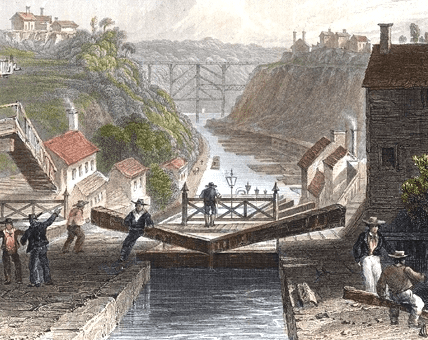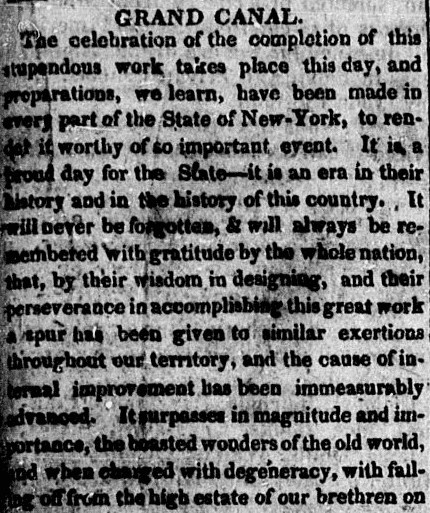The Erie Canal officially opened on 26 October 1825, ushering in a new era of trade and expanding westward migration for the young United States. This 363-mile engineering marvel, begun in 1817, connected the waters of Lake Erie to the Hudson River, on down to New York City and the Atlantic Ocean. The port of New York City became the nation’s busiest and most important, as easy navigation was now established from the country’s interior to the eastern seaboard.

New York marked the great day with a “Grand Celebration” that included the firing of cannons along the entire waterway’s length, from Buffalo on Lake Erie to the terminus at New York City’s harbor – an explosive demonstration that took 90 minutes to complete!
Newspapers that day recognized the historic dimensions of the canal’s opening. The completion of the canal was a great source of national pride; this 1825 newspaper article proclaims:
It [the canal] surpasses in magnitude and importance, the boasted wonders of the old world, and when charged with degeneracy, with falling off from the high estate of our brethren on the other continent [i.e., Europe], we can point them to this as a complete refutation of their injurious aspersions.

Here is a transcription of this article:
Grand Canal.
The celebration of the completion of this stupendous work takes place this day, and preparations, we learn, have been made in every part of the State of New York, to render it worthy of so important [an] event. It is a proud day for the State – it is an era in their history and in the history of this country. It will never be forgotten, & will always be remembered with gratitude by the whole nation, that, by their wisdom in designing, and their perseverance in accomplishing this great work a spur has been given to similar exertions throughout our territory, and the cause of internal improvement has been immeasurably advanced. It surpasses in magnitude and importance, the boasted wonders of the old world, and when charged with degeneracy, with falling off from the high estate of our brethren on the other continent, we can point them to this as a complete refutation of their injurious aspersions.
To New York are we indebted for Steam-Boats, and these, together with the immediate benefits and indirect but operative influence of the Grand Canal, will do more to increase the convenience of trading, to extend the facilities of communication between different parts of our country, and thereby remedy the evils arising from our greatly extended territory, than has been done by all the rest of the nation together, or, we apprehend, ever will or can be done. Canals will strengthen our bond of union – will afford a ligament to tie us together and to unite our interests; and the easy communications afforded by Steam-Boats will, by more intimate acquaintance, remove those prejudices against each other which arise from ignorance, and those jealousies and petty rivalships which exist between the different portions of our country. We notice this event as one of great honor to the State of New York, and of great interest to us all.
Note: An online collection of newspapers, such as GenealogyBank’s Historical Newspaper Archives, is not only a great way to learn about the lives of your ancestors – the old newspaper articles also help you understand American history and the times your ancestors lived in, and the news they talked about and read in their local papers. Did any of your ancestors help build the Erie Canal? Please share your stories with us in the comments section.
Related Article:
